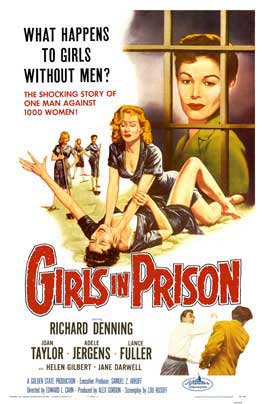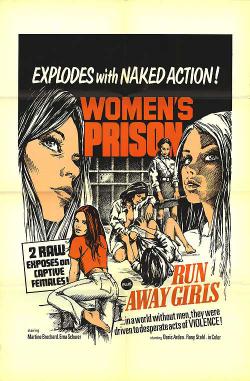Serendip is an independent site partnering with faculty at multiple colleges and universities around the world. Happy exploring!
The Eroticization and Objectification of Female Inmates



I was first struck by the eroticization of female inmates when I was researching images of female offenders for Barb’s vision class, but it wasn’t until I saw the “sexy prisoner” costumes that I thought more carefully about the subject. A Google search of “women in prison” turns up a number of movie posters for pornographic or erotic films set in prison. That such a serious and life altering experience could be reduced to a sexual spectacle made me cringe. One of the recurring focuses of the erotic films was the fact that a women’s prison brought a number of women together into one place – and allowed no heterosexual outlet for pleasure. For the most part they ignored the presence of male prison guards and rape culture in women’s prisons and focused instead on a fetishizing of homosexual relationships. Compared to the experience in male prisons, “lesbianism was believed to be trivial and harmless” (Pardue, Arrigo, & Murphy 2011). In addition, studies have shown that heterosexual men view lesbianism more favorably than they do homosexuality among men (Louderback & Whitley, Jr. 1997). In a study performed in 1977 by Nyberg and Alston (Louderback & Whitley, Jr. 1997), respondents were asked to rate ideas of same-sex interactions as either erotic or non-erotic. The results showed, “only 7% of both male and female respondents found the idea of a man making love to another man erotic. However, 33% of [the] male respondents found the idea of a woman making love to another woman erotic, compared to only 10% of their female respondents.” The idea that heterosexual males find lesbian encounters erotic helps to explain why female inmates are so eroticized – they’re in a situation in which they are surrounded almost exclusively by other women.

Even when the homosexuality is not the focus of erotic interest in prisons, female inmates are still depicted as hypersexual women. The musical and 2002 film “Chicago” follows the story of two women on death row for murder and their attempt to avoid execution by becoming stars. A famous scene in the musical is the performance for the song, “Cell Block Tango” – a scene that a number of students in our class posted as popular culture representations of prison. In the 2002 movie, the performance is incredibly sexual – with women dancing on the prison bars and wearing low-cut leotards or bikinis. They are all in prison for killing their male partners, so the musical establishes very clearly that they are all heterosexual women, but the women go on to use the prison as a space to express their sexual natures in dance. Though the film is clearly not an accurate representation of a women’s prison experience, it is a popular culture icon and therefore plays a big role in influencing conceptions of the experience. Popular culture can be seen as a form of education, so the fact that prison culture is so misrepresented by eroticism has serious consequences; that information is then being taught to our society without any push back or questioning.

In addition to eroticization, female inmates face a compounded level of objectification because as prisoners, society often fails to view them as individuals. I would also argue that a similar kind of objectification exists regarding women’s colleges. I often face the assumption that I must either be desperate for a heterosexual encounter or be a lesbian because of the school I attend and the fact that it is a “single-sex” institution – and I don’t think my experience is an isolated one. In our 360, we are reduced to objects by society both as we enter Bryn Mawr’s campus and as we pass through security at the prison we’re visiting. This parallelism is one of many between Bryn Mawr as a single-sex institution and women’s prisons, and I think it’s one of the most troubling because of the patriarchal power structure it reinforces.
A movement among feminists has been occurring recently to combat the objectification of women in the media and popular culture, and the female experience in prisons is one that has not been mentioned when discussing this. Popular culture should not be the sole place Americans learn about female inmate experience – but right now, it’s one of the only options, and it’s creating an incredibly problematic set of assumptions about the experience. Now that feminists are focusing their eye on “sexy” Halloween costumes, the prison ones should be looked at far more critically. Do we as a society want to eroticize the prison experience and dress up as a “sexy” prisoner? And moving past that, do we as a society want to trivialize the prison experience by wearing prison clothing as a costume?
Works Cited:
Louderback, L. A., & Whitley, Jr., B. E. (1997). Perceived erotic value of homosexuality and sex-role attitudes as mediators of sex differences in heterosexual college students' attitudes towards lesbians and gay men. The Journal of Sex Research, 34(2), 175-182.
Nyberg, K.L.,& Alston, J.P.(1977). Homosexual labeling by university youths. Adolescence, 12, 541-546.
Pardue, A., Arrigo, B. A., & Murphy, D. S. (2011). Sex and sexuality in women's prisons: A preliminary typological investigation. The Prison Journal, 91(3), 279-304. doi: 10.1177/0032885511409869
*The movie images are taken directly from a google image search for "women in prison"


